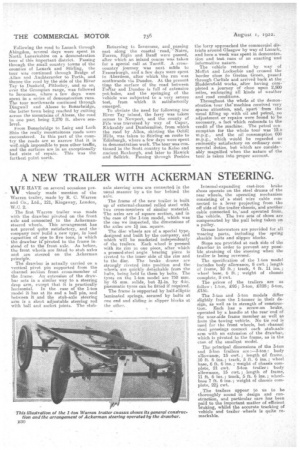A NEW TRAILER WITH ACKERMAN STEERING.
Page 14

If you've noticed an error in this article please click here to report it so we can fix it.
WE HAVE on several occasions previously made mention of the Warren trailer, made by H. C. Warren and Co., Ltd., 121, Kingsway, London, W.C. 2..
The first Warren trailer was made with the drawbar pivoted on the front axle and connected to the Ackermansteered wheels. This arrangement has not proved quite satisfactory, and the company now build a new type, in load capacities of one to five tons, in which the drawbar itpivoted to the frame instead of to the front axle. As before, the front wheels are fitted to stub axles and are steered on the Ackerman principle. The drawbar is actually carried on a vertical pivot pin supported from the channel section front cross-member of the frame. An extension of the drawbar acts in a similar way to a steering drop arm, except that it is practically horizontal. In the case of the 1-ton model it has at its end a ball pin, and between it and the stub-axle steering arm is a short adjustable steering rod with ball and socket joints. The stub axle steering arms are connected in the usual manner by a tie bar behind the axle.
The frame of the new trailer is built up of external-channel rolled steel with two cross-members of similarmaterial. The axles are of square section, and in the case of the 1-ton model, which was the one we inspected, the dimensions of the axles are 1 ins. square.
The disc wheels are of a special type, designed and built by the company, and which will be marketed independently of the trailers. Each wheel is pressed with its rim in one piece, after which a pressed-steel angle bracing piece is riveted to the inner side of the rim and
to the disc. The brake drums are strongly riveted into position and the wheels are quickly detachable from the hubs, being held to them by bolts. The tyres on the 1-ton model are 750 rum. by 45 mm. solids, but 31-in. by 4-in, pneumatic tyres can be fitted if required.
The frame is supported by half-elliptic laminated springs, secured by bolts at one end and sliding in slipper blocks at the other. Internal-expanding cast-iron brake shoes operate on the steel drums of the rear wheels, the operating mechanism consisting of a. steel wire cable connected to a lever projecting from the off side of the trailer chassis, and another cable connected to, and operated from, the vehicle. The two sets of shoes are compensated by the pull being taken on a pulley.
Grease lunrieators are provided for, all wearing parts, including the spring shackle bolts and slipper blocks.
Stops are provided at each side of the drawbar in order to prevent any possible straining of the steering when the trailer is being reversed.
The specification of the 1-ton model includes body allowance, 8 cwt. ; length of frame, 10 ft.; track, 4 ft. 11 ins.; wheel base, 6 ft.; weight of chassis complete, 8 cwt.
The prices of the trailers are as follow : 1-ton, £95; 3-ton, £125; 5-ton, £150.
The 3-ton and 5-ton models differ slightly from the 1-tonner in their design, as well as in strength of construction. Each has a screw-on brake, operated by a handle at the rear end of the near-side frame member as well as from the towing vehicle. No tie rod is used for the front wheels, but channel steel pressings connect each stub-axle arm with an extension of the drawbar, which is pivoted to the frame, as in the case of the smallest model.
The principal dimensions of the 3-ton and 5-ton trailers are :-3-ton : body alIowance, 15 ,ew4.; length srf frame, . 10 ft.. 6 ins.; track, 5 ft. 6 ins.; wheel base, 6 ft. 6 ins.; weight of chassis com plete, 21 cwt. 5-ton trailer: body allowance, 15 cwt.; .length of frame, 11 ft. 6 ins.; track, 5 ft. 6 ins.; wheelbase 7 ft. 6 ins.; weight of chassis complete, 221 cwt.
The trailers appear to us to be thoroughly sound in design and conatruction, and particular care has been paid to the important matter of efficient btaking, whilst the accurate tracking of vehicle and trailer wheels is quite remarkable.






























